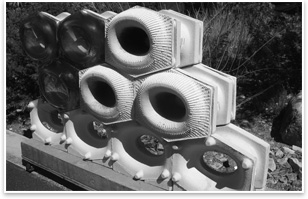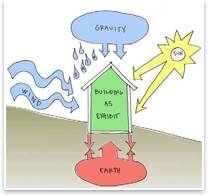|
AIA Awards Four 2008 Upjohn Research Grants
Summary: Four projects received Upjohn Research grants October 1 for work to be completed within 18 months. Named for the AIA’s first president, Richard Upjohn, these grants provide matching funds of up to $30,000 for applied research projects, which this year include environmental design case studies, ceramic materials innovation, environmental learning libraries, and thermally active surfaces.
The AIA Board Knowledge Committee’s Upjohn Research program gives preference to proposals that team academics and practitioners. The research must relate to one or more domains of architectural knowledge—leadership, practice, design, or building performance—and be framed within one of six broad research agenda areas: social, technological, environmental, cultural, organizational, or design. These grants qualify recipients to have their findings and outcomes published both electronically and in a nationally distributed publication.
The four projects receiving grants this year are:
Project: Cradle to Grave: Case Studies of Buildings’ Environmental Footprint
Researchers: Dan Jacobs, A3C Architects; Ash Ragheb, Center for Sustainability, Lawrence Technological University
By studying multiple buildings throughout their life span, this research allows a whole-building approach to estimating the environmental impact of buildings from their materials, systems, and component interactions. Calculating emissions to air, water, and land, the study will look at structure, enclosure, roofing, walls and partitions, and finishes to show the total impact of a building to the environment. Cases include recent LEED®-certified as well as conventional construction to highlight differences. Through the EPA environmental impact categories, the study gives a balanced view of both immediate and local impacts (e.g., human toxicity and smog formation) and long-term or global impacts (e.g., global warming, depletion of ozone and nonrenewable resources, and acid rain formation). The result will be a document to inform architects on the environmental impact of their design decisions, including alternatives shown to reduce the environmental impact of buildings.
 Program: EcoCeramic Phase II: High Performance Masonry Enclosure Program: EcoCeramic Phase II: High Performance Masonry Enclosure
Researchers: Jason Oliver Vollen, Center for Architectural Sciences, associate professor, Rensselaer Polytechnic Institute, principal, Binary Design; Kelly Winn, doctoral candidate, Rensselaer Polytechnic Institute; Jed Laver, researcher, University of Arizona
From the hand-crafted ceramic tiles mounted on structural steel framing at the turn of the 20th century till now, the ceramic tile has been appreciated for its durability, properties of thermal mass and humidity control, and structural stability. Yet, the art of building with ceramics has fallen by the wayside. Affording a resilient construction system based on sustainable and ecological principles and a streamlined design and manufacturing process, EcoCeramic Phase I combined ceramics and glass fiber to create a new material with both multidimensional and recombinant performance. The initial prototypical masonry units are locally post-tensioned, and the composite system eliminates the need for steel reinforcing or structural framing. By employing digital simulation and fabrication technologies, the investigators have created environmentally tuned surface tiles that absorb or reject thermal radiation. Phase II will develop the EcoCeramic masonry unit into a weatherproof, self supporting enclosure system that revives the historic and artistic traditions of the terracotta aesthetic.
 Program: Guidelines for the Design of Sustainable Learning Laboratories that Teach Through Architecture Program: Guidelines for the Design of Sustainable Learning Laboratories that Teach Through Architecture
Researcher: Jim Jones, PhD, director, CHPLE, Virginia Tech
The Center for High Performance Learning Environments (CHPLE), and the School of Education at Virginia Tech, in cooperation with the Southwest Virginia Science Museum, science educators, the International Institute for Sustainable Labs (I2SL), and Spectrum Design, will promote “buildings that teach” and environmental stewardship with the development of a new AIA learning module, based on recent research, that describes knowledge-based links between learning, critical thinking, and architecture while directly establishing design strategies that transform learning environments such as schools from passive vessels to active participants in learning. CHPLE participation on the designs for the Shenandoah Valley Discovery Museum and an Environmental Learning Center for Southwest Virginia helped Jones map interrelationships between pedagogical issues and building systems. By further developing this map, the program will develop guidelines to assist architects in designing environments that directly support learning. In addition, a group of middle school students from Southwest Virginia will participate in a mock design of an “environmentally responsive” building. Through a similar qualitative approach, dimensions of student learning related to architecture and the environment will be identified and translated to architectural decision making.
Project: Thermally Active Surfaces in Architecture
Researcher: Kiel Moe, assistant professor, School of Architecture, Northeastern University
This body of research focuses on the new role of thermally active surfaces in architecture towards low- to no-energy-consumption buildings. In this transformation of energy and building practices, the thermal conditioning of a building is decoupled from the ventilation system by using the mass of the building itself as the thermal system rather than air, reinvesting the fabric of the building itself as the primary mechanical system. The result: radically lower energy consumption, more durable and healthier buildings, and more integrated building systems and design teams. Low-tech yet high-performance thermally active surfaces are equally applicable in the developed and developing worlds. Parallel strains of research, including advanced energy modeling of 10 contemporary case studies, will lead to the first and only book on this sustainable technique. Participation by the architects, engineers, and climate consultants for these 10 projects will ensure the book is practice-driven and will elucidate principles and practices for direct implementation.
|


 Program: EcoCeramic Phase II: High Performance Masonry Enclosure
Program: EcoCeramic Phase II: High Performance Masonry Enclosure Program: Guidelines for the Design of Sustainable Learning Laboratories that Teach Through Architecture
Program: Guidelines for the Design of Sustainable Learning Laboratories that Teach Through Architecture